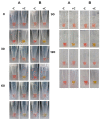Clinical Validation of a Colorimetric Loop-Mediated Isothermal Amplification Using a Portable Device for the Rapid Detection of SARS-CoV-2
- PMID: 37046573
- PMCID: PMC10093461
- DOI: 10.3390/diagnostics13071355
Clinical Validation of a Colorimetric Loop-Mediated Isothermal Amplification Using a Portable Device for the Rapid Detection of SARS-CoV-2
Abstract
Quick and reliable mass testing of infected people is an effective tool for the contingency of SARS-CoV-2. During the COVID-19 pandemic, Point-of-Care (POC) tests using Loop-Mediated Isothermal Amplification (LAMP) arose as a useful diagnostic tool. LAMP tests are a robust and fast alternative to Polymerase Chain Reaction (PCR), and their isothermal property allows easy incorporation into POC platforms. The main drawback of using colorimetric LAMP is the reported short-term stability of the pre-mixed reagents, as well as the relatively high rate of false-positive results. Also, low-magnitude amplification can produce a subtle color change, making it difficult to discern a positive reaction. This paper presents Hilab Molecular, a portable device that uses the Internet of Things and Artificial Intelligence to pre-analyze colorimetric data. In addition, we established manufacturing procedures to increase the stability of colorimetric RT-LAMP tests. We show that ready-to-use reactions can be stored for up to 120 days at -20 °C. Furthermore, we validated both the Hilab Molecular device and the Hilab RT-LAMP test for SARS-CoV-2 using 581 patient samples without any purification steps. We achieved a sensitivity of 92.93% and specificity of 99.42% (samples with CT ≤ 30) when compared to RT-qPCR.
Keywords: Point-of-Care; RT-LAMP; SARS-CoV-2; colorimetric; diagnostics.
Conflict of interest statement
The authors declare no conflict of interest. M. V. M. F. is the CEO at Hi Technologies LTDA; S. R. R. Jr is the CTO at Hi Technologies LTDA; B. M. M. A. is the CMO at Hi Technologies LTDA. B. W. R., F. J. R., R. B., G. J. S., L. M. I., E. Y. S. K., E. B. S., L. F. H., J. V. P., B. M. D., D. R. P. N., work or worked at Hi Technologies LTDA and do not declare any competing interest. M. B. N., J. S. S., B. G. S. work at Virology Laboratory at Universidade Federal do Paraná and do not declare any competing interest.
Figures






Similar articles
-
Optimization and Clinical Validation of Colorimetric Reverse Transcription Loop-Mediated Isothermal Amplification, a Fast, Highly Sensitive and Specific COVID-19 Molecular Diagnostic Tool That Is Robust to Detect SARS-CoV-2 Variants of Concern.Front Microbiol. 2021 Nov 18;12:713713. doi: 10.3389/fmicb.2021.713713. eCollection 2021. Front Microbiol. 2021. PMID: 34867841 Free PMC article.
-
Comparative analysis of loop-mediated isothermal amplification (LAMP)-based assays for rapid detection of SARS-CoV-2 genes.Sci Rep. 2021 Nov 18;11(1):22493. doi: 10.1038/s41598-021-01472-3. Sci Rep. 2021. PMID: 34795308 Free PMC article. Clinical Trial.
-
Development and Clinical Application of a Rapid and Sensitive Loop-Mediated Isothermal Amplification Test for SARS-CoV-2 Infection.mSphere. 2020 Aug 26;5(4):e00808-20. doi: 10.1128/mSphere.00808-20. mSphere. 2020. PMID: 32848011 Free PMC article.
-
A concise discussion on the potential spectral tools for the rapid COVID-19 detection.Results Chem. 2021 Jan;3:100138. doi: 10.1016/j.rechem.2021.100138. Epub 2021 May 6. Results Chem. 2021. PMID: 33972921 Free PMC article. Review.
-
The perspectives of biomarker-based electrochemical immunosensors, artificial intelligence and the Internet of Medical Things toward COVID-19 diagnosis and management.Mater Today Chem. 2021 Jun;20:100443. doi: 10.1016/j.mtchem.2021.100443. Epub 2021 Feb 11. Mater Today Chem. 2021. PMID: 33615086 Free PMC article. Review.
Cited by
-
Data treatment methods for real-time colorimetric loop-mediated isothermal amplification reactions.Sci Rep. 2023 Sep 1;13(1):14397. doi: 10.1038/s41598-023-40737-x. Sci Rep. 2023. PMID: 37658115 Free PMC article.
-
Improved protocol for Bst polymerase and reverse transcriptase production and application to a point-of-care diagnostics system.Exp Biol Med (Maywood). 2023 Oct;248(19):1671-1683. doi: 10.1177/15353702231215815. Epub 2023 Dec 13. Exp Biol Med (Maywood). 2023. PMID: 38088106 Free PMC article.
-
Extraction-Free Colorimetric RT-LAMP Detection of SARS-CoV-2 in Saliva.Diagnostics (Basel). 2023 Jul 11;13(14):2344. doi: 10.3390/diagnostics13142344. Diagnostics (Basel). 2023. PMID: 37510088 Free PMC article.
References
-
- Dao Thi V.L., Herbst K., Boerner K., Meurer M., Kremer L.P., Kirrmaier D., Freistaedter A., Papagiannidis D., Galmozzi C., Stanifer M.L., et al. A Colorimetric RT-LAMP Assay and LAMP-Sequencing for Detecting SARS-CoV-2 RNA in Clinical Samples. Sci. Transl. Med. 2020;12:eabc7075. doi: 10.1126/scitranslmed.abc7075. - DOI - PMC - PubMed
LinkOut - more resources
Full Text Sources
Miscellaneous

